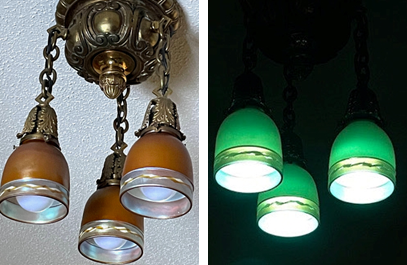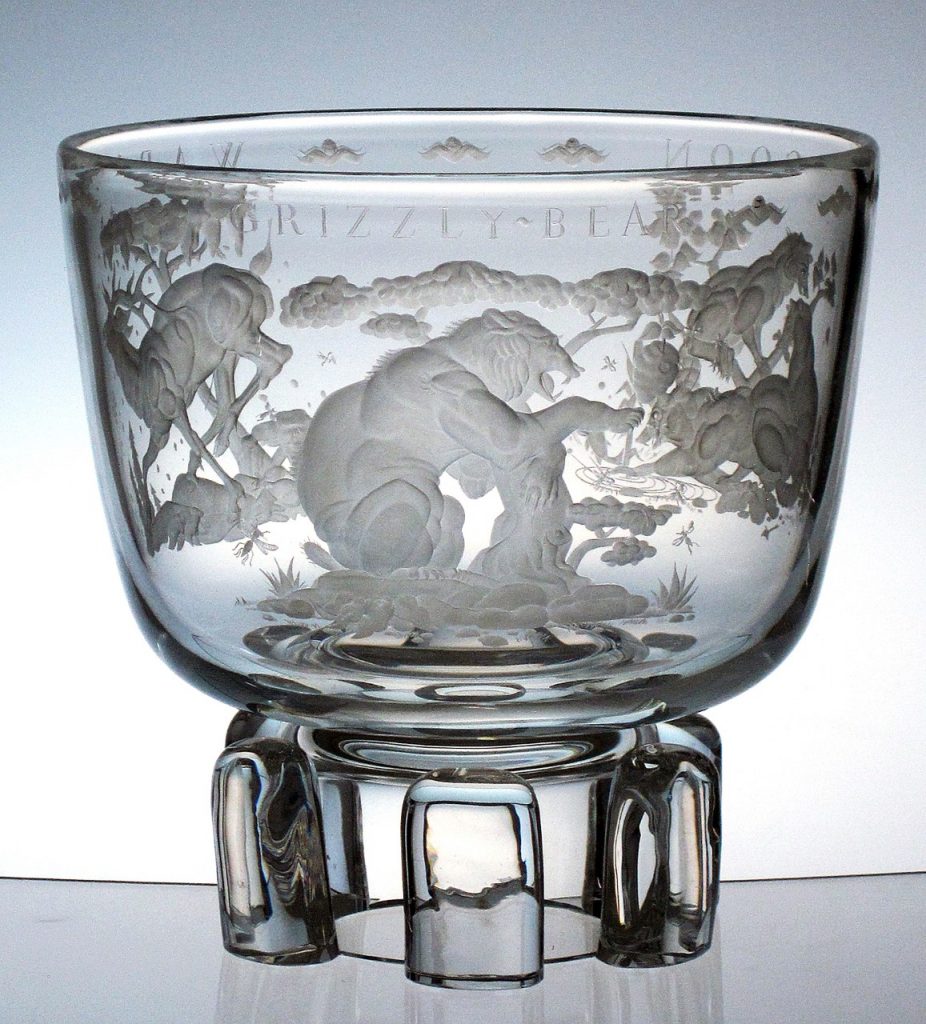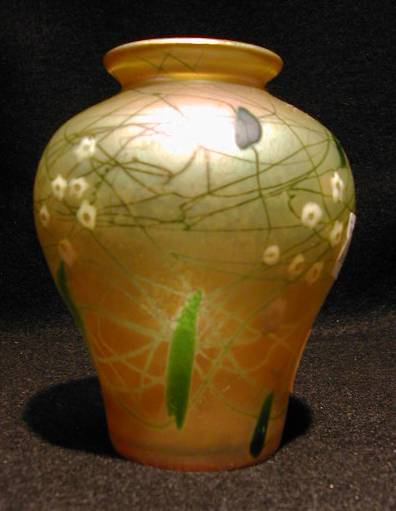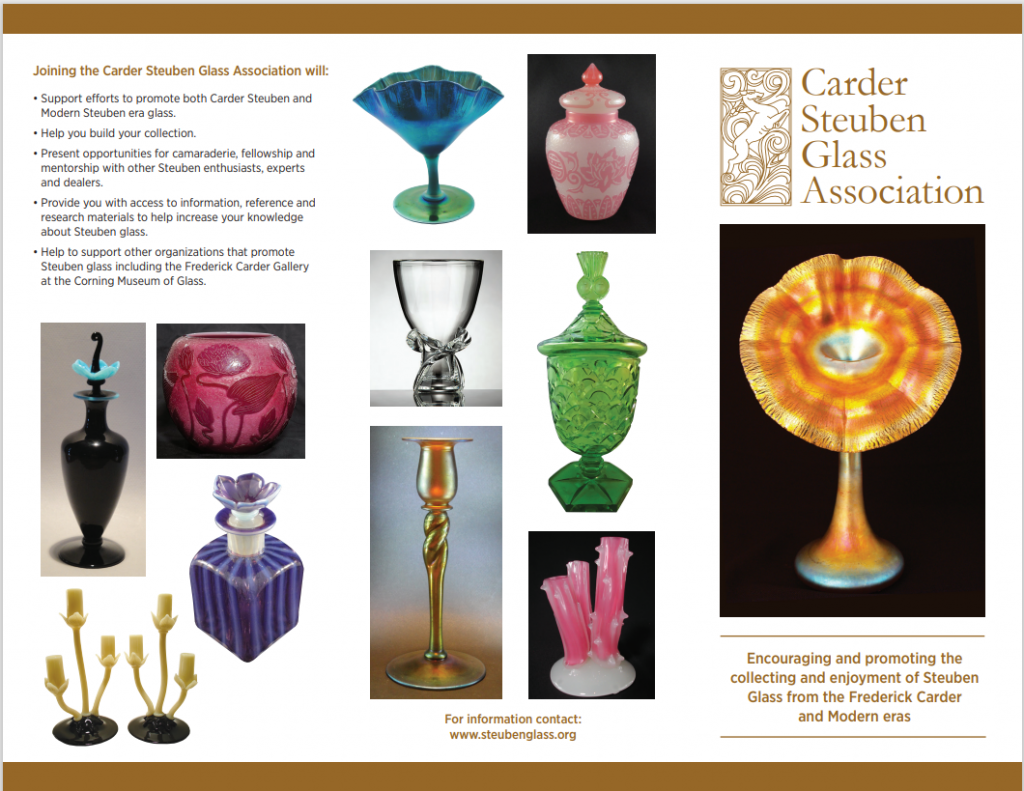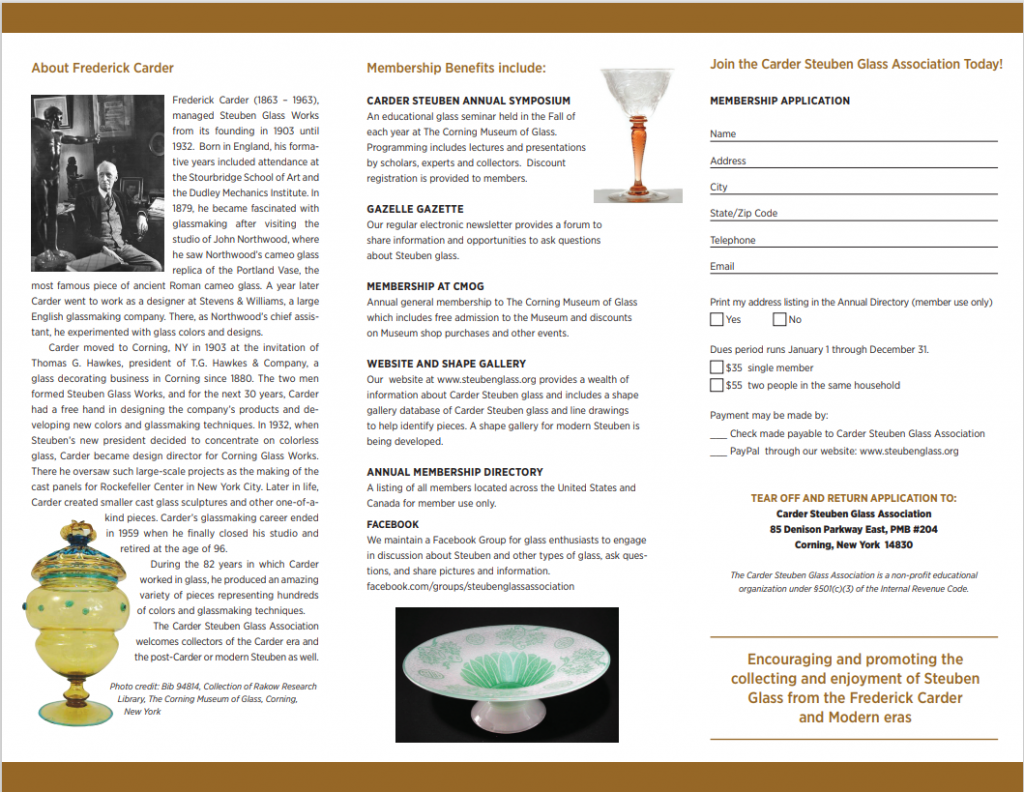Lighting Steuben Glass
May 30, 2022
Issue 3637
CSGA member Brad Withers asked a question about considerations for lighting glass such as Steuben. We hope to offer some suggestions in this article.
Successful collectors of Steuben glass will eventually find themselves in the position of needing to answer a recurring question with each new acquisition: Where do I put it? An ideal location gives us the opportunity to both admire and protect our treasured pieces. At the time they were produced most Steuben objects were intended to be used, but now that they are antique collectibles even plates and goblets are typically reserved for display cabinets. Steuben lamps and lamp shades can be an exception to this, providing collectors an opportunity to display the glass while using them for their original purpose. For all of these pieces, we want to exhibit their splendor and fine craftsmanship – to show them in their best light, so to speak.
Since 1878 when Thomas Edison first applied for a patent on his version of a practical incandescent lamp, lighting technology has continued to evolve. Today there are many different bulb types, shapes, wattages, intensities, and colors available, giving the collector many options and decisions to make. Here are some points to consider when choosing how to light your glass.
Bulb Types – This is where some of the biggest advances in lighting technology have occurred, and will continue to evolve.
- Incandescent: These bulbs work by incandescence, the emission of electromagnetic radiation (including visible light) from a hot body as a result of its high temperature. The light is produced in a broad spectrum that more closely resembles natural light than some other bulb types. However, incandescent bulbs are not energy efficient – less than 10% of electrical power supplied to the bulb is converted into visible light. The remaining energy is lost as heat.
- Halogen: A halogen light bulb is a type of incandescent bulb that contains an inert gas such as bromine or iodine that is heated and bonded to vaporizing tungsten molecules each time the light fixture is turned on. Halogen light bulbs have a longer lifespan, higher luminous efficacy, and higher color temperature compared to incandescent light bulbs, but they consume about the same amount of energy to operate.
- Compact Fluorescent: CFL light bulbs emit light from a mixture of phosphors that are contained inside the body of the bulb. They contain mercury and so must be disposed of properly. CFL bulbs are designed to produce the same amount of light as incandescent bulbs, except that they use less energy and last much longer. Modern CFL bulbs utilize a spiral design to make them more compact.
- Light-Emitting Diode: LEDs emit light by passing a voltage through a semiconductor microcircuit. The controlled flow of electrons releases energy and, with it, small flashes of light at particular frequencies. LED bulbs are much more efficient than incandescent bulbs and are available in a range of color “temperatures” to choose from.
Shape – The base of the lightbulb must match the socket and will determine the range of bulb shapes available. Several common shapes are available including candelabras, globes, torpedoes, and rings. If the bulb will be inside the glass (as in shades or internally lit lamps) choose a shape that will allow ample space between the bulb and the glass to allow for cooling.
Wattage and Intensity – In the older days of incandescent bulbs wattage and light intensity (measured in lumens) were correlated. The higher the wattage, the brighter the bulb. Today, wattage is no longer viewed as a reliable way to gauge light bulb brightness due to the advances in LED technology. LED bulbs have lower wattage ratings than incandescent or halogen bulbs, despite being equal in brightness. Comparing bulbs based on intensity will provide a better comparison point. If you are choosing bulbs to light an older lamp, do not select high wattage or high lumens. For all applications, do not select a bulb that has higher wattage than the rating of the wiring and socket.
Color Spectrum – This is an important factor in choosing the look of your glass, as much can depend on the color of light from the bulb. Natural sunlight contains the full spectrum of wavelengths within the visible portion of the electromagnetic spectrum, and colors tend to look more natural to us when illuminated with sunlight. Artificial light sources can have narrow color spectrums with wave peaks higher in certain parts of their spectrums, and this changes the look of objects that they illuminate. Fluorescent bulbs have narrow peaks in the color spectrum and tend to give a blue cast. This is part of the reason why the light from fluorescent bulbs can be very unappealing. If you like the warm, natural glow of incandescence, a halogen light bulb is a good alternative for pendants and other fixtures. LED bulbs come in a range of colors and, depending on the bulb, can be changed to light in a particular color or mimic a broader range of the color spectrum. LED colors are denoted by their temperature measured in Kelvin, and typically ranges from 2700 K (“warm” light) to 5000 K (“cool white”).
Bulbs can also be selected intentionally to get a particular look from your glass. An interesting example is below, where Brown Aurene on Calcite shades appear brown in natural daylight, but can be made to glow green when lit using LED “Hue” bulbs.
When lighting your collection keep in mind the lighting in a museum is different from lighting in a home. If your lighting source is going to be in close proximity to the glass, choosing an efficient, low-heat bulb type will prevent the glass from heating up each time the light is turned on. For general lighting of a glass display, the broad frequency spectrum generated from halogen lights provides excellent color rendering and allows the glass to sparkle. Transparent glass also looks magnificent when light is shining through it (as from behind) rather than directly cast on the object.
For any fixtures that you have, and in particular if it is a recently acquired lamp, be sure the wiring is up to date and that you have the proper pronged plug. It is best to have the wiring done by a professional.
If you have Steuben lamps on display at home, ensure they are out of reach of small humans and pets. Antique lamps are also not best as a strong source of light. Despite their utilitarian origins it’s now best to think of these pieces as art objects rather than household furnishings, and to supplement the room lighting with modern lighting sources.
If you have any tips you’d like to pass along to other members, please share by emailing Gazette@SteubenGlass.org.
CSGA MEMBER VIRTUAL SOCIAL
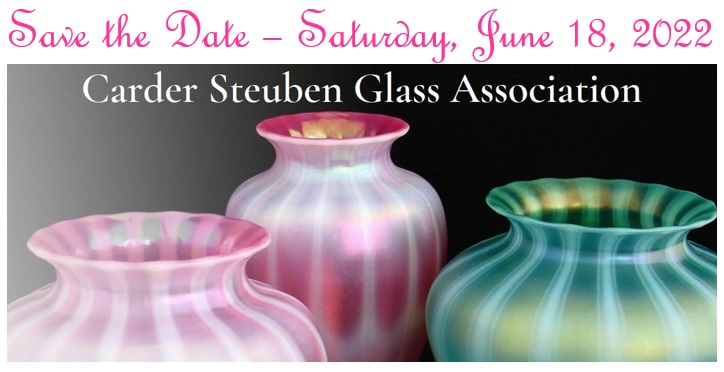
Come join your Carder Steuben Glass Association friends at our next virtual gathering, held via Zoom. We’ll be meeting Saturday, June 18, 2022 from 4:00-6:00pm EDT (1:00-3:00pm PDT). This is a light, fun way to meet some of the other CSGA members and enjoy a discussion about glass. Please feel free to bring a favorite piece to share or come with your questions for other members. Detailed information, a meeting link, and password will be sent to CSGA Members a few days before the session. We look forward to seeing you!
NEW BROCHURES AVAILABLE
We have recently printed new brochures to share information about the Carder Steuben Glass Association. The brochures are a single, tri-folded sheet that describes the CSGA mission, has links to resources like the steubenglass.org website, and contains information on becoming a member. If you are a shop owner, antique dealer, or someone else who would like to distribute brochures to interested glass afficionados, please reach out to Bonnie Salzman at Symposium@SteubenGlass.org and she will arrange to get a stack to you.
UPCOMING EVENTS
- June 18, 2022 CSGA Member Zoom Social 4:00-6:00pm EDT
- September 8-10, 2022 Save the date for this year’s Symposium, to be held at the Corning Museum of Glass in Corning, New York
AUCTIONS FEATURING STEUBEN GLASS
- Taylor & Harris – June 5, 2022
- Akiba Antiques – June 7, 2022
- Dan Morphy – June 9, 2022
- Jaremos – June 15, 2022
